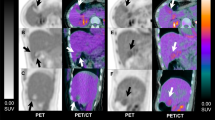Abstract
Proper interpretation of PET-CT images requires knowledge of the normal physiological distribution of the tracer, frequently encountered physiological variants, and benign pathological causes of FDG uptake that can be confused with a malignant neoplasm. In addition, not all malignant processes are associated with avid tracer uptake. A basic knowledge of the technique of image acquisition is also required to avoid pitfalls such as misregistration of anatomical and scintigraphic data. This article reviews these potential pitfalls as they apply to the abdomen and pelvis of patients with cancer.























Similar content being viewed by others
References
Czernin J, Allen-Auerbach M, Schelbert HR (2007) Improvements in cancer staging with PET/CT: literature-based evidence as of September 2006. J Nucl Med 48(Suppl 1):78S–88S.
Cohade C, Osman M, Leal J, Wahl RL (2003) Direct comparison of (18)F-FDG PET and PET/CT in patients with colorectal carcinoma. J Nucl Med 44(11):1797–803.
Blake MA, Singh A, Setty BN, et al. (2006) Pearls and pitfalls in interpretation of abdominal and pelvic PET-CT. Radiographics 26(5):1335–1353.
Osman MM, Cohade C, Nakamoto Y, et al. (2003) Clinically significant inaccurate localization of lesions with PET/CT: frequency in 300 patients. J Nucl Med 44(2):240–243.
Vogel WV, van Dalen JA, Wiering B, et al. (2007) Evaluation of image registration in PET/CT of the liver and recommendations for optimized imaging. J Nucl Med 48(6):910–919.
Emmott J, Sanghera B, Chambers J, Wong WL (2008) The effects of N-butylscopolamine on bowel uptake: an 18F-FDG PET study. Nucl Med Commun 29(1):11–16.
Kapoor V, McCook BM, Torok FS (2004) An introduction to PET-CT imaging. Radiographics 24(2):523–543.
Sureshbabu W, Mawlawi O (2005) PET/CT imaging artifacts. J Nucl Med Technol 33(3):156–161. quiz 63–64.
Trojan J, Schroeder O, Raedle J, et al. (1999) Fluorine-18 FDG positron emission tomography for imaging of hepatocellular carcinoma. Am J Gastroenterol 94(11):3314–3319.
Anderson CD, Rice MH, Pinson CW, et al. (2004) Fluorodeoxyglucose PET imaging in the evaluation of gallbladder carcinoma and cholangiocarcinoma. J Gastrointest Surg 8(1):90–97.
Kim JY, Kim MH, Lee TY, et al. (2008) Clinical role of 18F-FDG PET-CT in suspected and potentially operable cholangiocarcinoma: a prospective study compared with conventional imaging. Am J Gastroenterol 103(5):1145–1151.
Rini JN, Leonidas JC, Tomas MB, Palestro CJ (2003) 18F-FDG PET versus CT for evaluating the spleen during initial staging of lymphoma. J Nucl Med 44(7):1072–1074.
Sugawara Y, Zasadny KR, Kison PV, Baker LH, Wahl RL (1999) Splenic fluorodeoxyglucose uptake increased by granulocyte colony-stimulating factor therapy: PET imaging results. J Nucl Med 40(9):1456–1462.
Lustberg MB, Aras O, Meisenberg BR (2008) FDG PET/CT findings in acute adult mononucleosis mimicking malignant lymphoma. Eur J Haematol 81(2):154–156.
Nakamoto Y, Saga T, Ishimori T, et al. (2000) FDG-PET of autoimmune-related pancreatitis: preliminary results. Eur J Nucl Med 27(12):1835–1838.
Bares R, Klever P, Hauptmann S, et al. (1994) F-18 fluorodeoxyglucose PET in vivo evaluation of pancreatic glucose metabolism for detection of pancreatic cancer. Radiology 192(1):79–86.
Friess H, Langhans J, Ebert M, et al. (1995) Diagnosis of pancreatic cancer by 2[18F]-fluoro-2-deoxy-d-glucose positron emission tomography. Gut 36(5):771–777.
Yun M, Kim W, Alnafisi N, et al. (2001) 18F-FDG PET in characterizing adrenal lesions detected on CT or MRI. J Nucl Med 42(12):1795–1799.
Maurea S, Mainolfi C, Bazzicalupo L, et al. (1999) Imaging of adrenal tumors using FDG PET: comparison of benign and malignant lesions. AJR Am J Roentgenol 173(1):25–29.
Shulkin BL, Thompson NW, Shapiro B, Francis IR, Sisson JC (1999) Pheochromocytomas: imaging with 2-[fluorine-18]fluoro-2-deoxy-d-glucose PET. Radiology 212(1):35–41.
Yeung HW, Grewal RK, Gonen M, Schoder H, Larson SM (2003) Patterns of (18)F-FDG uptake in adipose tissue and muscle: a potential source of false-positives for PET. J Nucl Med 44(11):1789–1796.
Abouzied MM, Crawford ES, Nabi HA (2005) 18F-FDG imaging: pitfalls and artifacts. J Nucl Med Technol 33(3):145–155. quiz 62–63.
Prabhakar HB, Sahani DV, Fischman AJ, Mueller PR, Blake MA (2007) Bowel hot spots at PET-CT. Radiographics 27(1):145–159.
Skehan SJ, Issenman R, Mernagh J, Nahmias C, Jacobson K (1999) 18F-fluorodeoxyglucose positron tomography in diagnosis of paediatric inflammatory bowel disease. Lancet 354(9181):836–837.
Hannah A, Scott AM, Akhurst T, et al. (1996) Abnormal colonic accumulation of fluorine-18-FDG in pseudomembranous colitis. J Nucl Med 37(10):1683–1685.
Shreve PD, Anzai Y, Wahl RL (1999) Pitfalls in oncologic diagnosis with FDG PET imaging: physiologic and benign variants. Radiographics 19(1):61–77. quiz 150-151.
Vesselle HJ, Miraldi FD (1998) FDG PET of the retroperitoneum: normal anatomy, variants, pathologic conditions, and strategies to avoid diagnostic pitfalls. Radiographics 18(4):805–823. discussion 23–24.
Lerman H, Metser U, Grisaru D, et al. (2004) Normal and abnormal 18F-FDG endometrial and ovarian uptake in pre- and postmenopausal patients: assessment by PET/CT. J Nucl Med 45(2):266–271.
Subhas N, Patel PV, Pannu HK, et al. 2005. Imaging of pelvic malignancies with in-line FDG PET-CT: case examples and common pitfalls of FDG PET. Radiographics 25(4):1031–1043.
Turlakow A, Yeung HW, Salmon AS, Macapinlac HA, Larson SM (2003) Peritoneal carcinomatosis: role of (18)F-FDG PET. J Nucl Med 44(9):1407–1412.
Author information
Authors and Affiliations
Corresponding author
Rights and permissions
About this article
Cite this article
McDermott, S., Skehan, S.J. Whole body imaging in the abdominal cancer patient: pitfalls of PET-CT. Abdom Imaging 35, 55–69 (2010). https://doi.org/10.1007/s00261-008-9493-4
Received:
Accepted:
Published:
Issue Date:
DOI: https://doi.org/10.1007/s00261-008-9493-4




